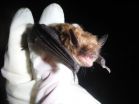(Press-News.org) A fungus that infects bats as they hibernate is killing them by the millions, placing three species in the East perilously close to being declared endangered — or perhaps beyond, towards extinction.
How to know the actual condition of the populations of different bat species is challenging.
Now a team of researchers from Virginia Tech, the U.S. Geological Survey, the U.S. Army Installation Command, and the U.S. Army Corps of Engineers has determined the most efficient ways to improve and modify a sampling technique that is already available.
Acoustic monitoring — listening to bats in their environment as they commute between feeding areas using echolocation to "see" their surroundings and find insect prey — has become commonplace over the last decade.
"It allows for detection of species richness more quickly and over a greater area than traditional capture methods," said Laci S. Coleman, who conducted research on the team as part of her master of science degree in fisheries and wildlife sciences, which she received from Virginia Tech in 2013.
And listening to bats is noninvasive, avoiding unintentional transfer of the spores of the fungus that causes white-nose syndrome that could occur with handling bats.
White-nose syndrome, which has spread from central New York to at least 25 states and five Canadian provinces since 2006, has caused the deaths of more than 6 million bats.
But there had been no research to determine the best placements of acoustic equipment to detect numerous species until Coleman and colleagues conducted research over the course of two years at Fort Drum, a U.S. Army facility in upstate New York.
With 168 square miles of forests, river, and wetlands, Fort Drum is home to several bat species, most notably the endangered Indiana bat, the northern long-eared bat currently proposed for endangered status, and the little brown bat, all of which have been impacted by white-nose syndrome.
Little brown bats, prior to the disease, were among the most numerous mammal species in all of New England, numbering in the millions.
"The Department of Defense is compelled to follow the Endangered Species Act," said W. Mark Ford, leader of the Virginia Cooperative Fish and Wildlife Research Unit and associate professor in Virginia Tech's College of Natural Resources and Environment, and Coleman's advisor. "Hence they are required to monitor the endangered Indiana bat to assess how military training, range sustainment, and other environmental stewardship efforts, such as forestry and ecological restoration, impact the species."
"The challenge is that, as a result of white-nose syndrome, you cannot monitor bats by catching them because there are too few," Ford continued. "But they are still there, and the act still applies. So we use acoustics to say 'present here, go slow; absent here, go ahead.'"
Coleman is the lead author of a study on the most efficient placement of acoustic bat detectors, which was published Feb. 28 in the Journal of Ecology and the Natural Environment.
The researchers deployed acoustic bat detectors across Fort Drum in various sampling arrays. They specifically targeted sites with open space, such as gaps in forest canopies and over water, where many bat species forage.
The researchers determined that a grid with 15 units produced the highest detection of most species.
On the other hand, transect sampling — setting up a line of detectors for a week, then moving them — sampled a much greater area with greater variation of habitat than permanent stations deployed for the entire season, but required more effort.
"Transect sampling is a time-consuming commodity that busy natural resource managers tasked with maintaining military installations have in very short supply, considering today's management demands," said Ford.
The big brown bat, which is only moderately impacted by white-nose syndrome, and bats species not impacted by the fungus were detected widely regardless of the sampling array.
The endangered Indiana bat and little brown bat required both long-term sampling and transect sampling over a wide area in order to determine that they were even present, even though researchers were aware of their historic roosting and foraging areas.
Not having that type of information made detection even more challenging for species such as the tri-colored and northern long-eared bats.
"For species like the northern long-eared bat or tri-colored bat for which Fort Drum managers do not have as much historic maternity colony data, we have to 'think like a bat' and try to monitor in areas of suitable habitat or expected use on what we know about the species' natural history," Coleman explained.
The research concludes that "Deploying detectors across the widest area possible in areas of known previous use, expected use, or suitable habitat is likely more effective than deploying detectors for long periods or at permanent stations."
"We cannot really afford long-term study," said Ford. "Knowing how to determine population numbers relatively rapidly in a science-based way is important in order to move several of these species to endangered status and make land-use decisions accordingly."
"It is more important than ever to be able to detect them so they can be protected," added Coleman.
INFORMATION:
Additional resources are available at the Virginia Tech News website.
'Listening' helps scientists track bats without exposing the animals to disease
Monitoring, protecting bats critical as millions perish
2014-05-29
ELSE PRESS RELEASES FROM THIS DATE:
Family support may improve adherence to CPAP therapy for sleep apnea
2014-05-29
DARIEN, IL – A new study suggests that people with obstructive sleep apnea (OSA) who are single or have unsupportive family relationships may be less likely to adhere to continuous positive airway pressure (CPAP) therapy.
Results show that individuals who were married or living with a partner had better CPAP adherence after the first three months of treatment than individuals who were single. Higher ratings of family relationship quality also were associated with better adherence. Results were adjusted for potential confounding factors including age, gender and body ...
Heavy airplane traffic potentially a major contributor to pollution in Los Angeles
2014-05-29
Congested freeways crawling with cars and trucks are notorious for causing smog in Los Angeles, but a new study finds that heavy airplane traffic can contribute even more pollution, and the effect continues for up to 10 miles away from the airport. The report, published in the ACS journal Environmental Science & Technology, has serious implications for the health of residents near Los Angeles International Airport (LAX) and other airports around the world.
Scott Fruin, D.Env. P.E., Neelakshi Hudda and colleagues note that past research has measured pollution from air ...
Creatures of habit: Disorders of compulsivity share common pattern and brain structure
2014-05-29
People affected by binge eating, substance abuse and obsessive compulsive disorder all share a common pattern of decision making and similarities in brain structure, according to new research from the University of Cambridge.
In a study published in the journal Molecular Psychiatry and primarily funded by the Wellcome Trust, researchers show that people who are affected by disorders of compulsivity have lower grey matter volumes (in other words, fewer nerve cells) in the brain regions involved in keeping track of goals and rewards.
In our daily lives, we make decisions ...
New laser sensing technology for self-driving cars, smartphones and 3-D video games
2014-05-29
WASHINGTON, May 29, 2014—A new twist on 3-D imaging technology could one day enable your self-driving car to spot a child in the street half a block away, let you answer your Smartphone from across the room with a wave of your hand, or play "virtual tennis" on your driveway.
The new system, developed by researchers at the University of California, Berkeley, can remotely sense objects across distances as long as 30 feet, 10 times farther than what could be done with comparable current low-power laser systems. With further development, the technology could be used to make ...
Parasitic fig wasps bore with zinc-hardened drill bit tips
2014-05-29
Female insects have one goal in life: to find the best place to lay their eggs. For fig wasps, that is the developing fruit of the luscious fig plant. However, when one particular parasitic fig wasp (Apocryta westwoodi grandi) descends onto a recently fertilised fruit, she has to bore her way through the tough unripe fig to find the larvae of other insects that are already developing within, which she will then parasitize to give her own eggs the best start. Fortunately, the insect's immensely long (7–8mm) and slender (~15 μm) ovipositor – which injects eggs into the ...
What shaped it, how old is it, and are they connected?
2014-05-29
Boulder, Colo., USA - Two articles recently published online for the journal LITHOSPHERE investigate the influence of climate, erosion, and tectonics on the lay of the land in the Bolivian Andes. Nicole Gasparini of Tulane University and Kelin Whipple of Arizona State University tackle rainfall patterns, rock uplift, and the distribution of crustal deformation caused by tectonics. In both studies, they conclude that tectonics win out over rainfall when it comes to shaping Earth' surface in the area.
Other new articles cover (1) isotopic dating of volcanic rocks in the ...
UT Arlington nursing professor studying online students' stress, sense of belonging
2014-05-29
As a nursing professor assigned to one of UT Arlington's first online master's degree courses, Ronda Mintz-Binder had a stake in learning to motivate students online. Now, she's building on her experience with a research project that will help other professors.
Mintz-Binder, who holds a master's degree in psychiatric/mental health nursing and a doctorate in nursing educational leadership, received two grants from the Dallas-based education company Academic Partnerships to initiate a multi-year study comparing the experiences of on-campus and online master's degree students. ...
Microalgae capable of assimilating the NH3 resulting from the management of agrifood waste
2014-05-29
The Basque Institute for Agricultural Research and Development, Neiker-Tecnalia, the public body that reports to the Sub-Ministry for Agriculture, Fisheries and Food Policy of the Government of the Basque Autonomous Community, has confirmed the capacity of Chlamydomonas acidophila microalgae to absorb ammoniacal nitrogen present in the effluent generated in the digestion of organic waste coming from the agri-food sector. These algae can grow in these liquids and assimilate the ammonium, which prevents this gas from being volatilised in the form of ammonia (NH3) and contaminating ...
Dentists' knowledge, confidence tied to care for scleroderma patients
2014-05-29
What: A survey of dentists in Massachusetts suggests that their confidence in treating patients with scleroderma may be related to their familiarity with the autoimmune disease. Dentists who reported feeling knowledgeable about scleroderma felt more prepared to provide care to patients with scleroderma, when compared to peers who did not feel as knowledgeable. Providing education to dentists may improve patient satisfaction and access to care, while simultaneously increasing dentists' knowledge and comfort.
Background: Scleroderma, derived from the Greek words for "hard ...
Zinc deficiency before conception disrupts fetal development
2014-05-29
Female mice deprived of dietary zinc for a relatively short time before conception experienced fertility and pregnancy problems and had smaller, less-developed fetuses than mice that ingested zinc during the same times, according to researchers in Penn State's College of Agricultural Sciences.
The findings have implications for human reproduction, scientists suggest.
Going without zinc prior to ovulation had marked effects on the mice's reproductive functions. Zinc deficiency caused a high incidence of pregnancy loss, and embryos from the zinc-deficient diet group were ...
LAST 30 PRESS RELEASES:
Injectable breast ‘implant’ offers alternative to traditional surgeries
Neuroscientists devise formulas to measure multilingualism
New prostate cancer trial seeks to reduce toxicity without sacrificing efficacy
Geometry shapes life
A CRISPR screen reveals many previously unrecognized genes required for brain development and a new neurodevelopmental disorder
Hot flush treatment has anti-breast cancer activity, study finds
Securing AI systems against growing cybersecurity threats
Longest observation of an active solar region
Why nail-biting, procrastination and other self-sabotaging behaviors are rooted in survival instincts
Regional variations in mechanical properties of porcine leptomeninges
Artificial empathy in therapy and healthcare: advancements in interpersonal interaction technologies
Why some brains switch gears more efficiently than others
UVA’s Jundong Li wins ICDM’S 2025 Tao Li Award for data mining, machine learning
UVA’s low-power, high-performance computer power player Mircea Stan earns National Academy of Inventors fellowship
Not playing by the rules: USU researcher explores filamentous algae dynamics in rivers
Do our body clocks influence our risk of dementia?
Anthropologists offer new evidence of bipedalism in long-debated fossil discovery
Safer receipt paper from wood
Dosage-sensitive genes suggest no whole-genome duplications in ancestral angiosperm
First ancient human herpesvirus genomes document their deep history with humans
Why Some Bacteria Survive Antibiotics and How to Stop Them - New study reveals that bacteria can survive antibiotic treatment through two fundamentally different “shutdown modes”
UCLA study links scar healing to dangerous placenta condition
CHANGE-seq-BE finds off-target changes in the genome from base editors
The Journal of Nuclear Medicine Ahead-of-Print Tip Sheet: January 2, 2026
Delayed or absent first dose of measles, mumps, and rubella vaccination
Trends in US preterm birth rates by household income and race and ethnicity
Study identifies potential biomarker linked to progression and brain inflammation in multiple sclerosis
Many mothers in Norway do not show up for postnatal check-ups
Researchers want to find out why quick clay is so unstable
Superradiant spins show teamwork at the quantum scale
[Press-News.org] 'Listening' helps scientists track bats without exposing the animals to diseaseMonitoring, protecting bats critical as millions perish



